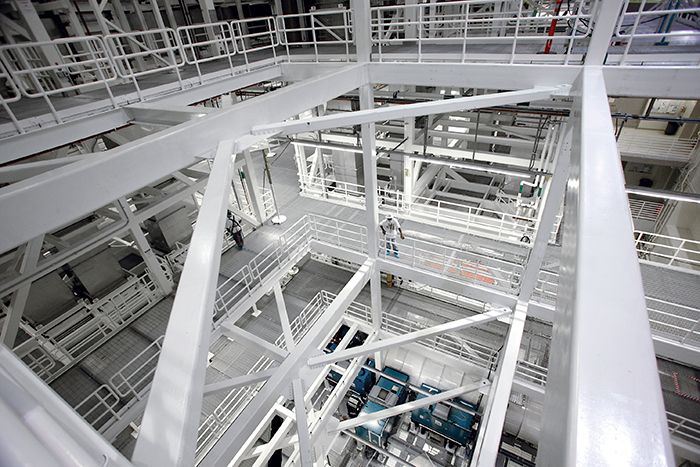NIF: An Engineering Marvel
November 16, 2023
NIF is a remarkable engineering and technology success story. Materials scientists and laser physicists, working with engineers, designed a facility that contains 7,500 large (meter-scale) optics, 26,000 small optics, and more than 66,000 control points. The optics and other components are contained in approximately 6,200 complex modular devices called line replaceable units (LRUs), which can be replaced quickly when necessary to ensure continuous operation of the facility.
The NIF laser pulses travel one kilometer from initial pulse formation in the Master Oscillator Room to the target in 4.5 microseconds, arriving at the Target Chamber center within 30 picoseconds of each other with an accuracy of 50 microns. Achieving this level of pointing stability and absolute accuracy on target was an engineering challenge of the first order, requiring rock-solid stability in the optics support systems, precise placement and alignment of components—despite a multitude of opportunities for errors to creep in—and a rigorously accurate computer timing system.
To meet these challenges, all of the structures holding NIF’s mirrors and lenses were carefully designed with extreme stability in mind. At the beginning of the project—before any hardware had been designed—precise vibration measurements of the ground at the site were made.
 Inside one of NIF’s two switchyards. These highly stable 10-story structures contain beam enclosures with turning mirrors that redirect the beams to the upper and lower hemispheres of the Target Chamber. The switchyards convert the parallel laser beam layout to the spherical configuration of the Target Chamber, as the beams need to enter the chamber along radial lines to converge on the target.
Inside one of NIF’s two switchyards. These highly stable 10-story structures contain beam enclosures with turning mirrors that redirect the beams to the upper and lower hemispheres of the Target Chamber. The switchyards convert the parallel laser beam layout to the spherical configuration of the Target Chamber, as the beams need to enter the chamber along radial lines to converge on the target.
The engineering team characterized every local vibration source including pumps, motors, and transformers, and estimated their effect on each of the most sensitive laser components—generally the laser mirrors. The budget for vibration (>1Hz) and drift (<1Hz) was met using this detailed model, and tests on the prototype beamline demonstrated performance at or better than the 50-micron requirement. In addition, to ensure beamline components do not infringe on the laser clear aperture, precision survey techniques were employed for a rigid survey network and well-controlled physical placement for all beamline components. All beam enclosures, support systems, and the Target Chamber are located to an accuracy of one-fourth of a millimeter.
This information was then provided to the design team, which engineered structures that were both stiff enough and had sufficient damping that the response of the structures to ground vibration and the anticipated vibration from building equipment would meet overall stability requirements. The design solutions included thick concrete foundations, lightweight steel platforms, and extensive vibration isolation mechanisms at all sources of vibration. Exhaustive structural analyses were conducted to convince the engineers of the feasibility of the design, and a comprehensive construction plan was executed to assure that all design details were meticulously implemented. As a result of this integrated and comprehensive end-to-end program, NIF has been able to achieve all of its stability requirements on a routine basis.
Ensuring that all 192 beams arrive within 30 picoseconds of the prescribed arrival time is achieved by using a precise timing system which is constantly updating its internal clocks using the GPS satellite system. Integrated software and hardware constantly monitor and update the timing to maintain accuracy. LRUs can be readily exchanged to maintain the timing accuracy through design tolerances of better than 300 femtoseconds (three-tenths of a trillionth of a second) for each mechanical interface. In addition, tightly controlled procedures maintain system timing for each LRU.
—Charlie Osolin
Follow us on Twitter: @lasers_llnl



